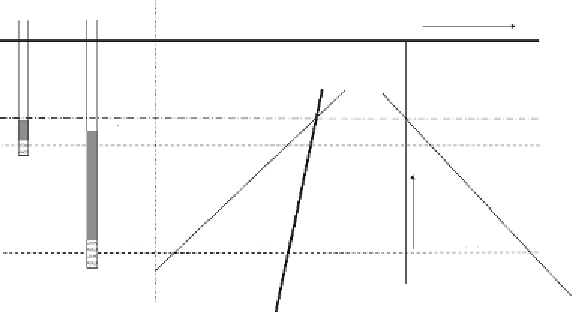Geoscience Reference
In-Depth Information
Head diagram
piezometers
z
,
h
, and
H
0
soil surface
H
z
h
groundwater level
z
= -100 cm
-80 cm
-90 cm
-80 cm
+20 cm
z
-90 cm
+110 cm
z
= -200 cm
Figure 4.6
Piezometers in shallow groundwater with corresponding Head diagram.
directed downward. Note that in this case the soil water pressure head
h
increases in
the direction of low. So never use gradients of
h
to determine the low direction!
4.3.2 Hydraulic Head of Soil Water
Storage or retention of soil water in the vadose zone is a result of attractive forces
between the solid and liquid phases. These '
matrix
'
forces
enable the soil to hold
water against forces or processes such as gravity, evaporation, uptake by plant roots,
etc. There are three mechanisms for binding of water to the solid matrix (Koorevaar
et al.,
1983
):
•
Direct adhesion of water molecules to solid surfaces by London-van der Waals forces
•
Capillary binding of water
•
Osmotic binding of water in double layers
Water molecules are attracted to solid surfaces by various types of London-van der
Waals forces. These are strong, but very short-range forces: they diminish with about
the 6th power of the distance. Thus only a very thin water layer is adsorbed in this
way around soil particles. Because these adhesive forces are so strong that the water
cannot move or be extracted by plant roots, this form of water retention in itself is
insigniicant for storage, transport and plant growth. However, the adhesive forces,
together with the cohesive forces between water molecules, form the basis for capil-
lary binding of soil water. This is the most important mechanism of binding of water
in moderate to coarse soils.
Capillary binding might be illustrated by inserting a ine glass tube in a water reser-
voir (
Figure 4.7
). Water will rise in the glass tube, until it reaches a maximum height
z
c
. The forces that act between the water molecules at a water interface are called sur-

Search WWH ::

Custom Search